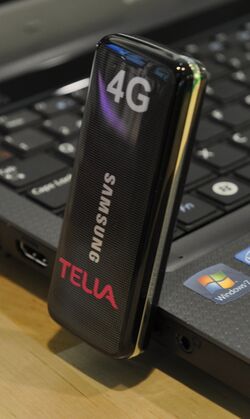4G
(communications technology) | |
|---|---|
 Telia-branded Samsung LTE modem | |
| Predecessor(s) | 3G |
| Successor(s) | 5G |
| Mobile internet access standard | |
4G is the fourth generation of broadband cellular network technology, succeeding 3G, and preceding 5G. It was the most used standard during the 2010s. Potential and current applications include amended mobile web access, IP telephony, gaming services, high-definition mobile TV, video conferencing, and 3D television.
In the field of mobile communications, a "generation" generally refers to a change in the fundamental nature of the service, non-backwards-compatible transmission technology, higher peak bit rates, new frequency bands, wider channel frequency bandwidth in Hertz, and higher capacity for many simultaneous data transfers (higher system spectral efficiency in bit/second/Hertz/site).
New mobile generations have appeared about every ten years since the first move from 1981 analog (1G) to digital (2G) transmission in 1992. This was followed, in 2001, by 3G multi-media support, spread spectrum transmission and a minimum peak bit rate of 200 kbit/s, in 2011/2012 to be followed by "real" 4G, which refers to all-Internet Protocol (IP) packet-switched networks giving mobile ultra-broadband (gigabit speed) access.
Health Concerns
Yes.[1]